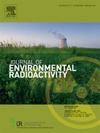用同位素方法评估典型日本杉林中福岛源放射性铯的准平衡分布
IF 2.1
3区 环境科学与生态学
Q3 ENVIRONMENTAL SCIENCES
引用次数: 0
摘要
在这项研究中,我们应用同位素方法评估了典型成熟日本杉林中福岛衍生的137Cs的准平衡。截至2020年,地上生物量区室(幼边材、剩余边材、心材、内树皮、外树皮、大树枝、小树枝、幼叶和老叶)的137Cs浓度与土壤向地上生物量转移的自然存在的稳定同位素铯(133Cs)的平衡浓度具有良好的相关性。表明137Cs的准平衡分布是在最初截获的放射性铯经过一段时间从生物质隔室中去除后实现的。估计2020年生物量中137Cs/133Cs的同位素浓度比为3.6⋅10−5 (μ kg−1)(μ kg−1)−1(95%置信区间(CI): 1.6⋅10−5 - 5.6⋅10−5)。5 cm表层土壤137Cs/133Cs同位素库存比略低,为(2.52±2.39)⋅10−5 (μg kg−1)(μg kg−1)−1,这可能表明2011年3月大气沉降物中截获了一定数量的137Cs,主要来自5 cm以下表层土壤。2017 - 2020年,地上生物量137Cs总存量稳定在生态系统总存量(3.1±1.7)%的水平。本文章由计算机程序翻译,如有差异,请以英文原文为准。
Assessing the quasi-equilibrium distribution of Fukushima-derived radiocesium in a typical Japanese cedar forest using an isotopic approach
In this study we applied an isotopic approach to assess a quasi-equilibrium of Fukushima-derived 137Cs in a typical mature Japanese cedar forest. As of 2020, the concentrations of 137Cs in the aboveground biomass compartments (young sapwood, rest of sapwood, heartwood, inner bark, outer bark, big branches, small branches, young foliage, and old foliage) correlated well with the equilibrium concentrations of the naturally occurring stable isotope of cesium (133Cs) transferred to the aboveground biomass from the soil, indicating that a quasi-equilibrium distribution of 137Cs has been achieved after a period of removal of the initially intercepted radiocesium from the biomass compartments. The isotope concentration ratio 137Cs/133Cs in the biomass as of 2020 is estimated as 3.6⋅10−5 (μg kg−1) (μg kg−1)−1 (95 % confidence interval (CI): 1.6⋅10−5 – 5.6⋅10−5). The isotope inventory ratio 137Cs/133Cs in the 5-cm topsoil is slightly lower, (2.52 ± 2.39)⋅10−5 (μg kg−1) (μg kg−1)−1, which may indicate the presence of some amounts of 137Cs intercepted from the atmospheric fallout in March 2011 in the biomass compartments and the predominant uptake of Cs isotopes from the topsoil layer thinner than 5 cm. The total 137Cs inventory in aboveground biomass stabilized between 2017 and 2020 at the level of (3.1 ± 1.7)% of its total inventory in the ecosystem.
求助全文
通过发布文献求助,成功后即可免费获取论文全文。
去求助
来源期刊

Journal of environmental radioactivity
环境科学-环境科学
CiteScore
4.70
自引率
13.00%
发文量
209
审稿时长
73 days
期刊介绍:
The Journal of Environmental Radioactivity provides a coherent international forum for publication of original research or review papers on any aspect of the occurrence of radioactivity in natural systems.
Relevant subject areas range from applications of environmental radionuclides as mechanistic or timescale tracers of natural processes to assessments of the radioecological or radiological effects of ambient radioactivity. Papers deal with naturally occurring nuclides or with those created and released by man through nuclear weapons manufacture and testing, energy production, fuel-cycle technology, etc. Reports on radioactivity in the oceans, sediments, rivers, lakes, groundwaters, soils, atmosphere and all divisions of the biosphere are welcomed, but these should not simply be of a monitoring nature unless the data are particularly innovative.
 求助内容:
求助内容: 应助结果提醒方式:
应助结果提醒方式:


